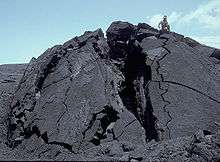Pressure ridge (lava)

A pressure ridge sometimes referred to as a tumulus (or tumuli in plural form) is created in an active lava flow.[1][2] Formation occurs when the outer edges and surfaces of the lava flow begin to harden.[1] If the advancing lava underneath becomes restricted it may push up on the hardened crust, tilting it outward.[1] Inflation also takes place and is a process where the plastic layer of lava underneath expands as it cools and small crystals form.[1] The end result is a raised mound of hardened lava rock, usually a relatively narrow but long ridge.[1] Tension cracks form on the surface of pressure ridges and run along the axis of elongated ridges, and at both edges of broader ridges, sometimes referred to as pressure plateaus.[1] Sometimes, along the edges of a pressure ridge, the tension crack can be large enough to create a liftup cave.[1] Other caves can form inside pressure ridges when the lava vacates leaving an inflationary cave.[3]
References
- 1 2 3 4 5 6 7 Chitwood, Lawrence A. (January 1989). "Inflated Lava" (PDF). Desert Ramblings, The Newsletter of the Oregon Natural Desert Association. Retrieved 2009-08-18.
- ↑ Nichols, Robert L. (1946). "Pressure Ridges and Collapse Depressions on the McCartys Basalt Flow, Valencia County, New Mexico" (PDF). Geological Society of America Bulletin. pp. 57, 1049–1086. Retrieved 2013-04-13.
- ↑ Matt Skeels. "Oregon High Desert Grotto". The Caves of Central Oregon. Retrieved 2013-07-07.